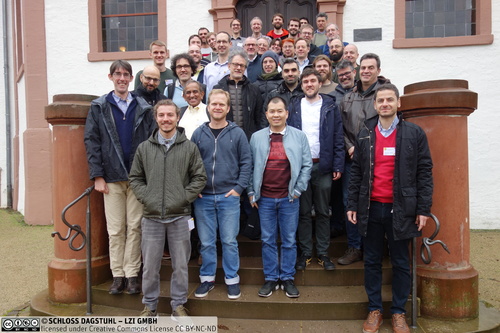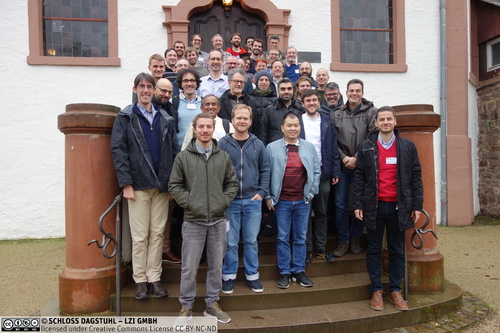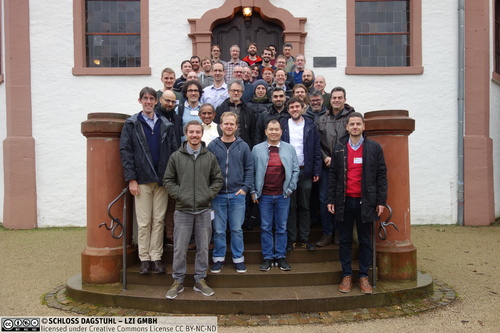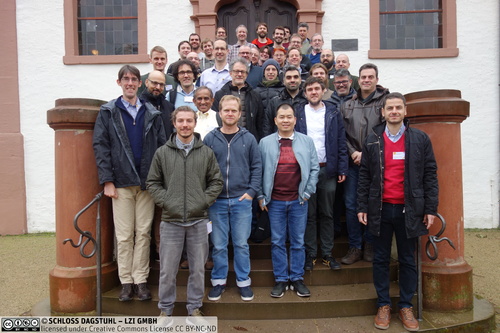Dagstuhl Seminar 20071
Foundations of Composite Event Recognition
( Feb 09 – Feb 14, 2020 )
Permalink
Organizers
- Alexander Artikis (NCSR Demokritos - Athens, GR)
- Thomas Eiter (TU Wien, AT)
- Alessandro Margara (Polytechnic University of Milan, IT)
- Stijn Vansummeren (Free University of Brussels, BE)
Contact
- Shida Kunz (for scientific matters)
Impacts
Schedule
Composite Event Recognition (CER for short), also known as Complex Event Recognition, refers to the activity of detecting patterns in streams of continuously arriving “event” data over (geographically) distributed sources. CER is a key ingredient of many contemporary applications that require the processing of such event streams in order to obtain timely insights and implement reactive and proactive measures. Examples of such applications include the recognition of attacks in computer network nodes, human activities on video content, emerging stories and trends on the Social Web, traffic and transport incidents in smart cities, error conditions in smart energy grids, violations of maritime regulations, cardiac arrhythmia, epidemic spread, and the monitoring of cyber-physical systems. In each application, CER allows to make sense of streaming data, react accordingly, and prepare for counter-measures.
Numerous CER systems and languages have been proposed in the literature. While these systems have a common goal, they differ in their architectures, data models, pattern languages, and processing mechanisms, resulting in many heterogeneous implementations with sometimes fundamentally different capabilities. Their comparative assessment is further hindered by the fact that they have been developed in different communities, each bringing in their own terminology and view of the problem. Moreover, the established CER literature focuses on the practical system aspects of CER. As a result, little work has been done on its formal foundations. Consequently, and in contrast to the situation for more traditional fields in Computer Science, we currently lack a common understanding of the trade-offs between expressiveness and complexity in the design of CER systems, as well as an established theory for comparing their fundamental capabilities.
As such, currently, CER frameworks are difficult to understand, extend and generalize. It is unclear which of the proposed approaches better meets the requirements of a given application domain, in terms of capturing the intended meaning of the composite events of interest, as well as detecting them efficiently. Furthermore, the lack of foundations makes it hard to leverage established results --- from automata theory, temporal logics, etc --- thus hindering scientific and technological progress in CER.
At the same time, recent years have witnessed increased activity in diverse fields of Computer Science on topics that are related to CER:
- inductive and deductive reasoning over streaming data, a field known as Stream Reasoning in Artificial Intelligence;
- theoretical complexity results related to processing database queries under updates, associated with advances in Incremental View Maintenance in Database research;
- expressiveness and complexity of logics in a dynamic setting, in Logic research.
Given this setting, the objective of this Dagstuhl Seminar is to:
- bring together world-class computer scientists and practitioners working on CER, Distributed Systems, Databases, Logic, Stream Reasoning and Artificial Intelligence;
- to disseminate the recent foundational results in each of these isolated fields among all participants;
- to identify the open problems that need to be resolved to provide general formal foundations of CER;
- to establish new research collaborations among these fields; thereby
- to start making progress towards formulating such foundations.
 Alexander Artikis, Thomas Eiter, Alessandro Margara, and Stijn Vansummeren
Alexander Artikis, Thomas Eiter, Alessandro Margara, and Stijn Vansummeren
Press Reviews
- Schloss Dagstuhl: Where computers science meets
Report by Sabri Skhiri in EURA NOVA, February 20, 2020
This report contains the program and outcomes of Dagstuhl Seminar 20071 on "Foundations of Composite Event Recognition" held at Schloss Dagstuhl, Leibniz Center for Informatics, during February 9-14, 2020.
Composite Event Recognition (CER for short) refers to the activity of detecting patterns in streams of continuously arriving "event" data over, possibly geographically, distributed sources. CER is a key ingredient of many contemporary Big Data applications that require the processing of such event streams in order to obtain timely insights and implement reactive and proactive measures. Examples of such applications include the recognition of attacks in computer network nodes, human activities on video content, emerging stories and trends on the Social Web, traffic and transport incidents in smart cities, error conditions in smart energy grids, violations of maritime regulations, cardiac arrhythmia, and epidemic spread. In each application, CER allows to make sense of streaming data, react accordingly, and prepare for counter-measures.
CER systems become increasingly important as we move from an information economy to an "intelligent economy", where it is not only the accessibility to information that matters but also the ability to analyse, reason, and act upon information, creating competitive advantage in commercial transactions, enabling sustainable management of communities, and promoting appropriate distribution of social, healthcare, and educational services. Current businesses tend to be unable to make sense of the amounts of data that are generated by the increasing number of distributed data sources that are becoming available daily, and rely more and more on CER. As an example, traffic management in smart cities requires the analysis of data from an increasing number of sensors, both mobile (mounted on public transport vehicles and private cars) and stationary (installed on intersections). Using such data streams, CER may be used to detect or even forecast traffic congestions, thus allowing for proactively changing traffic light policies and speed limits, with the aim of reducing carbon emissions, optimising public transportation, and improving the quality of life and productivity of commuters. As another example, in smart energy grids, streaming information from power grid elements sensors, end-user devices, and diverse other sources such as weather forecasts and event schedules can be combined through CER to improve the grid efficiency and meet the rapidly increasing electricity demand.
Numerous CER systems and languages have been proposed in the literature. While these systems have a common goal, they differ in their architectures, data models, pattern languages, and processing mechanisms, resulting in many heterogeneous implementations with sometimes fundamentally different capabilities. Their comparative assessment is further hindered by the fact that they have been developed in different communities, each bringing in their own terminology and view of the problem.
Moreover, the established CER literature focuses on the practical system aspects of CER. As a result, little work has been done on its formal foundations. Consequently, and in contrast to the situation for more traditional fields in Computer Science, we currently lack a common understanding of the trade-offs between expressiveness and complexity in the design of CER systems, as well as an established theory for comparing their fundamental capabilities.
As such, currently, CER frameworks are difficult to understand, extend and generalise. It is unclear which of the proposed approaches better meets the requirements of a given application domain, in terms of capturing the intended meaning of the composite events of interest, as well as detecting them efficiently. Furthermore, the lack of foundations makes it hard to leverage established results -- from automata theory, temporal logics, etc -- thus hindering scientific and technological progress in CER.
At the same time, recent years have witnessed increased activities in diverse fields of Computer Science on topics that are related to CER: Inductive and deductive reasoning over streaming data, a field known as Stream Reasoning in Artificial Intelligence. Theoretical complexity results related to processing database queries under updates, associated with advances in Incremental View Maintenance in Database Research. Expressiveness and complexity of logics in the dynamic setting, in Logic research.
The seminar brought together 39 researchers and practitioners working in domains that are strictly related to CER. The first days of the seminar mainly focused on tutorials and talks that gave an overview of the approaches, techniques, methodologies, and vocabularies used in different communities to refer to CER problems. In particular, the following tutorials were presented:
- Applications and requirements for CER
- CER in data management
- CER in distributed event-based systems
- Stream reasoning
- CER in logic and AI
- CER in business process management
The seminar continued by alternating sessions with focused research talks and group discussions on the following topics, that the participants identified as the most relevant for future investigations and research efforts:
- CER language formalisms
- Towards a common framework for CER expressiveness and complexity
- Evaluation strategies: parallel and distributed processing
- Uncertainty in CER
- Pattern induction and composite event forecasting
- Benchmarking
The final sessions of the seminar focused on reporting the results of the group discussions and in planning follow-up activities, including co-organized workshops and events, joint publications, and projects.
 Alessandro Margara, Alexander Artikis, Thomas Eiter, and Stijn Vansummeren
Alessandro Margara, Alexander Artikis, Thomas Eiter, and Stijn Vansummeren
- Elias Alevizos (Demokritos - Athens, GR)
- Alexander Artikis (NCSR Demokritos - Athens, GR) [dblp]
- François Bry (LMU München, DE) [dblp]
- Diego Calvanese (Free University of Bozen-Bolzano, IT) [dblp]
- Daniele Dell'Aglio (Universität Zürich, CH)
- Emanuele Della Valle (Polytechnic University of Milan, IT) [dblp]
- Thomas Eiter (TU Wien, AT) [dblp]
- David Eyers (University of Otago, NZ) [dblp]
- Avigdor Gal (Technion - Haifa, IL) [dblp]
- Minos Garofalakis (Technical University of Crete - Chania, GR) [dblp]
- Alejandro J. Grez (PUC - Santiago de Chile, CL) [dblp]
- Sylvain Hallé (University of Quebec at Chicoutimi, CA) [dblp]
- Manfred Hauswirth (Fraunhofer FOKUS - Berlin, DE) [dblp]
- Fredrik Heintz (Linköping University, SE) [dblp]
- Annika M. Hinze (University of Waikato, NZ) [dblp]
- Boris Koldehofe (University of Groningen, NL) [dblp]
- Danh Le Phuoc (TU Berlin, DE) [dblp]
- Alessandro Margara (Polytechnic University of Milan, IT) [dblp]
- Wim Martens (Universität Bayreuth, DE) [dblp]
- Ruben Mayer (TU München, DE) [dblp]
- Angelo Montanari (University of Udine, IT) [dblp]
- Boris Motik (University of Oxford, GB) [dblp]
- Thomas Prokosch (LMU München, DE)
- Umakishore Ramachandran (Georgia Institute of Technology - Atlanta, US)
- Tore Risch (Uppsala University, SE) [dblp]
- Cristian Riveros (PUC - Santiago de Chile, CL) [dblp]
- Till Rohrmann (Ververica - Berlin, DE) [dblp]
- Kurt Rothermel (Universität Stuttgart, DE) [dblp]
- Sabri Skhiri (EURA NOVA - Mont-Saint-Guibert, BE) [dblp]
- Kostas Stathis (Royal Holloway, University of London, GB)
- Riccardo Tommasini (University of Tartu, EE) [dblp]
- Martin Ugarte (Millenium Institute - Santiago de Chile, CL) [dblp]
- Jacopo Urbani (VU University Amsterdam, NL) [dblp]
- Han van der Aa (HU Berlin, DE) [dblp]
- Stijn Vansummeren (Free University of Brussels, BE) [dblp]
- Matthias Weidlich (HU Berlin, DE) [dblp]
- Thomas Zeume (TU Dortmund, DE) [dblp]
- Holger Ziekow (HFU - Furtwangen, DE) [dblp]
Classification
- artificial intelligence / robotics
- data bases / information retrieval
- semantics / formal methods
Keywords
- Complex Event Processing
- Pattern Matching
- Stream Reasoning
- Temporal Reasoning
- Event Algebra





 Creative Commons BY 3.0 DE
Creative Commons BY 3.0 DE
